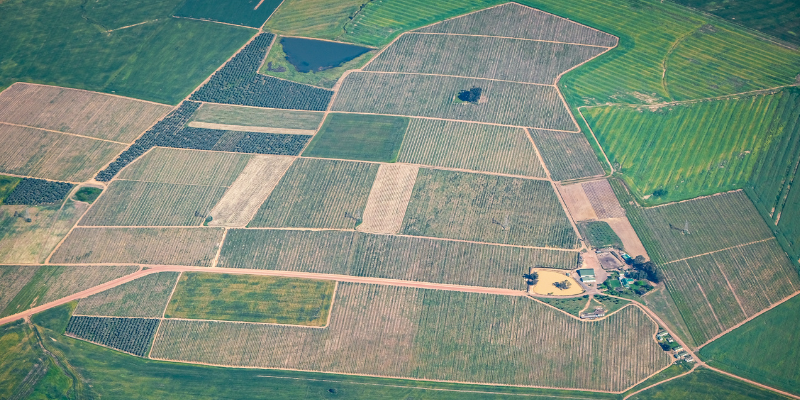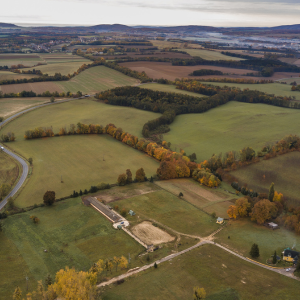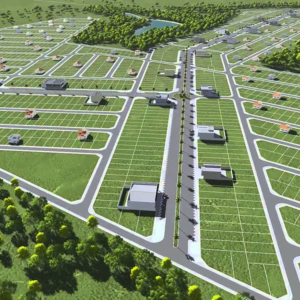
Understanding Land Measurements: What Does 100 Acres Look Like?
Anyone shopping for property in Texas, especially large tracts such as a hundred acres, really needs to grasp how land is measured. An acre roughly equals 43,560 square feet and is about the same area as a full-size football field.
A hundred acres is roughly the same as seventy-five football fields sitting side by side. Such an enormous chunk of real estate opens the door to many projects, whether you want to start a working farm or build a sprawling private residence.
In Texas, where room to roam is the norm, a hundred-acre tract may offer a mix of gentle hills, sunny pastures, and shady woods. Knowing how big 100 acres is helps buyers seeking privacy and profit plan wisely and match the land to their dreams and day-to-day needs.
Such knowledge is essential for appreciating the property’s size and envisioning its possibilities within the context of Texas’s unique landscape and real estate market dynamics. We Buy Land Quick can guide you through every step.
How Much Do 100 Acres of Land Look Like?
Imagine a stretch of ground that spans a full hundred acres- that’s a good chunk of Texas pasture, especially these days, when fresh subdivisions and strip malls emerge almost overnight. To put it into everyday terms, imagine about seventy-five football fields lined up next to each other; that sheer stretch of grass helps homebuyers grasp just how oversized the parcel is.
Out in Texas, where elbow room is a badge of honor, that much land opens the door to any dream you may have- building a roomy cattle ranch, starting an ag business, or just soaking up the peace that comes with breathing space. Because much of the state sits flat under a vast sky, those one hundred acres look and feel even larger, almost inviting you to fill all that open air with whatever plans you can imagine.
For prospective buyers seeking both investment opportunities and personal enjoyment, understanding the scale of 100 acres is crucial; it signifies potential and embodies the quintessential Texan dream of wide-open spaces and freedom.
How Many Football Fields Is 100 Acres of Land?

Grasping a 100-acre size can help any Texas home buyer avoid surprises once the land is walked on. A simple comparison often makes the numbers memorable: picture a standard football field beside the raw parcel.
A full NFL field-turf and end zones span around 1.32 acres. By that measure, one hundred acres roughly equals 75.76 such playing areas.
Viewing 100 acres as roughly seventy football fields gives a clear picture of how big that amount of ground really is. It offers ample elbow room for building homes, laying out parks, starting small farms, or pursuing almost any other idea a buyer might dream up across Texas’ varied scenery.
Whether you plan to raise a wide-ranging homestead or simply park money for future projects, grasping this scale guides smarter choices in today’s fast-moving Texas real estate scene.
Comparing Acreage Sizes: Visualizing 100 Acres in Different Contexts
For first-time homebuyers, imagining a Texas 100-acre spread can be challenging because the figure sounds almost abstract. Linking the number to places you already recognize makes it easier to picture what that much land offers.
Put simply, a hundred acres is roughly the same as laying seventy-five football fields back-to-back; that adds up to nearly three million square feet you can wander across. Inside a town, that footprint could cradle a large neighborhood park or a small set of city blocks, hinting at all the room it offers for fresh development and day-to-day farming.
In rural Texas, this land could support a sizable ranch with room for livestock, crops, and even a homestead with expansive views. For those interested in recreational opportunities, 100 acres could include hiking trails, fishing ponds, or wildlife habitats. This vastness provides endless possibilities for personal use or investment potential in the dynamic Texas real estate market.
Understanding these comparisons helps buyers appreciate the magnitude of owning such a large parcel of land and envision how it fits into their lifestyle aspirations.
How Big Is 1 Acre of Land in Texas?
An acre of land is a fundamental unit of measurement in Texas real estate, especially for prospective investor land buyers in San Antonio and surrounding cities in Texas seeking to understand the vastness of 100 acres. In simple terms, one acre is equivalent to 43,560 square feet.
To visualize this, imagine an area slightly smaller than a football field, approximately 48,000 square feet. For those exploring Texas real estate, grasping the size of an acre is crucial as it helps assess property dimensions and potential uses.
In rural Texas, where properties often span several acres, understanding how big one acre is can aid in making informed purchasing decisions. Whether you’re planning to build a home, start a ranch, or develop farmland, knowing that each acre offers ample space can guide you in evaluating the suitability of 100 acres for your real estate needs.
Therefore, when considering large parcels like 100 acres in Texas, it’s essential to recognize that such expanses provide significant opportunities for development and investment.
How Big in Miles Is 100 Acres?

When considering the vastness of 100 acres in Texas real estate, homebuyers must grasp how expansive this area is. One hundred acres translates to approximately 15625 square miles, providing substantial land that can accommodate various uses, from residential developments to agricultural pursuits.
In Texas, where land ownership is often tied to a sense of freedom and opportunity, understanding the size in miles helps potential buyers visualize the space’s potential. This knowledge is crucial for investing in Texas real estate, as it influences decisions on property layout, utilization, and future expansion possibilities.
Whether you’re envisioning a sprawling ranch or a secluded home with ample privacy, knowing that 100 acres equates to about 15625 square miles can help guide your real estate journey in the Lone Star State.
Real Estate Insights: Buying and Selling 100 Acres in Texas
Purchasing or selling 100 acres in Texas offers unique challenges and opportunities in the real estate market. With its expansive landscapes, Texas provides diverse properties, from lush woodlands to open prairies.
Cash land buyers in Houston and other Texas cities interested in acquiring 100-acre plots should consider location, accessibility, and zoning regulations that can significantly impact property value and potential uses. Proximity to urban centers like Austin or Dallas may increase investment potential, while more remote areas offer privacy and natural beauty.
Understanding water and mineral rights is crucial, as these can affect land use and future development possibilities. Sellers can attract buyers looking for specific features in a large parcel by showcasing the land’s unique attributes, such as agricultural viability or wildlife presence.
Working with experienced real estate professionals familiar with Texas’s vast terrain ensures that buyers and sellers efficiently navigate the complexities of transactions involving large tracts of land and maximize their real estate investments.
Legal Aspects to Consider When Purchasing or Inheriting Large Lands
Critical legal aspects must be considered when purchasing or inheriting vast lands such as 100 acres in Texas to ensure a smooth transaction. Prospective buyers should conduct a comprehensive title search to verify ownership and uncover any existing liens or encumbrances on the property.
Understanding zoning regulations and land use restrictions is essential, as these can significantly impact potential development plans or agricultural uses. It’s also important to review any easements that may grant others access to parts of the property.
Engaging with a real estate attorney specializing in large tracts of land can provide valuable insights into navigating mineral rights, particularly pertinent in Texas due to its rich oil reserves. Moreover, understanding water rights is crucial, as they dictate how water resources on the property can be used for irrigation or other purposes.
For those inheriting land, it’s vital to examine tax implications, including estate taxes and potential exemptions, which can influence long-term financial planning. By addressing these legal considerations proactively, homebuyers and inheritors can make informed decisions about their real estate investments in Texas’s expansive landscape.
Zoning Laws and Regulations for 100-acre Properties in Texas

Understanding the zoning laws and regulations is crucial for prospective homebuyers when considering the purchase of 100-acre properties in Texas. Zoning laws in Texas vary significantly between counties and municipalities, impacting how land can be used and developed.
These regulations determine whether a parcel can be utilized for agricultural, residential, commercial, or mixed-use purposes. For instance, some areas may have strict guidelines regarding developing residential communities on large tracts of land, while others might encourage agricultural use to support local farming initiatives.
Homebuyers should also be aware of any environmental restrictions that could affect their ability to build or modify structures on the property. Additionally, setbacks from roads and neighboring properties can influence where homes or other buildings can be situated within the acreage.
Consulting with local planning authorities and real estate experts familiar with Texas zoning laws is advisable to ensure compliance and fully understand the potential uses for a 100-acre property. This knowledge is essential for making informed decisions about investment opportunities and development plans in the diverse landscape of Texas real estate.
The History and Evolution of Texas Land Ownership
The history and evolution of Texas land ownership provide a fascinating backdrop for understanding the vastness of 100 acres in real estate terms. Initially, the land that is now occupied by various Indigenous tribes in Texas was occupied by multiple Indigenous tribes, each with its unique relationship to the land.
With the arrival of Spanish explorers in the 16th century, large swaths of territory were claimed under Spanish colonial rule, introducing European landownership concepts. Following Mexico’s independence from Spain, Texas became part of Mexico, leading to a new wave of land grants to encourage settlement.
These Mexican land grants laid the groundwork for many current property boundaries and influenced how Texans perceive real estate today. After Texas gained independence in 1836 and joined the United States in 1845, American settlers brought their ideas about property rights and land use.
The Homestead Act later spurred further development, as individuals could claim ownership by improving their parcels. Today, Texas’s diverse landscape offers homebuyers various options ranging from sprawling ranches to suburban lots, all deeply rooted in this rich tapestry of historical shifts in ownership patterns and legal frameworks.
Understanding these developments is crucial for modern homebuyers seeking insight into acquiring and managing sizable properties like a 100-acre tract within the dynamic Texan real estate market. Contact us to learn more.
Cultural Significance of Land Ownership Traditions in Texas History
The cultural significance of land ownership in Texas is deeply rooted in the state’s rich history, reflecting diverse traditions and historical influences. From the early Spanish land grants to the Republic of Texas era, owning land has symbolized freedom, prosperity, and sovereignty.
For many Texans, land ownership is not just an investment but a legacy passed down through generations. The vastness of 100 acres holds particular significance as it embodies both economic potential and a connection to the rugged spirit of the frontier.
Historically, large tracts of land were essential for cattle ranching, farming, and settlement expansion, shaping Texas’s identity as synonymous with open spaces and independence. This tradition resonates with modern homebuyers seeking to partake in Texas’s storied heritage by owning their piece of this expansive landscape, even if it includes unbuildable land, which can still offer recreational, agricultural, or conservation value despite limitations on development.
These deep-seated values influence current real estate trends and buyer preferences across Texas’s vast terrain.
Would you like to sell your house? Whether you need to sell fast, avoid expensive repairs, or just want a smooth sale, help from We Buy Land Quick is at hand. We take care of everything, make a reasonable cash offer, and make the whole thing easy. Are you prepared to sell, or do you have any inquiries? Get a free quote by calling (469) 529-7977 right now. Begin right now!
| REALTY | PRICE | LONGHORN REALTY | TERMS OF SERVICE | SEARCH RESULTS | |
| RANCHES FOR SALE | MESSAGE | MARKETING | BUTTON | ABOR |
Helpful Texas Blog Articles

